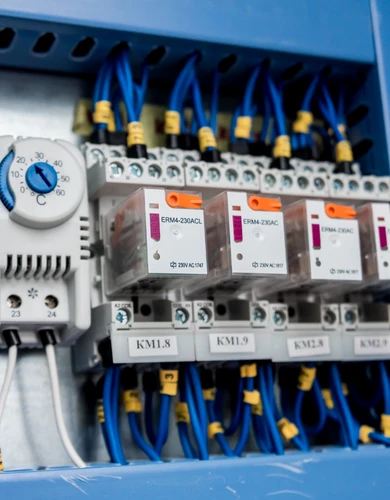DUoS (Distribution Use of System) charges for businesses
Distribution Use of System (DUoS) charges make up about 15% of all electricity bills paid by homes and businesses.
Put simply, it is the cost of moving electricity from the high-voltage national grid and delivering it to your property.
DUoS charges typically do not appear separately on bills. Still, for those interested in how they work, we’ve prepared this guide to the Distribution Use of System charges for businesses. Here’s what we cover:
- What are DUoS charges?
- Components of DUoS charges for businesses
- Factors affecting business DUoS charges
- Changes to business DUoS charges
What are DUoS charges?
DUoS (Distribution Use of System) charges are fees paid by businesses and households to cover the cost of maintaining, operating and upgrading the local electricity distribution networks in the UK.
DUoS charges pay for use of the local grid, in contrast to TNUoS charges and BSUoS charges, which pay for the national grid.
These extremely complex local grids comprise of multiple components, such as substations, transformers, underground and overground cables and different types of business electricity meters.
These DUoS charges are set by your Distribution Network Operator (DNO) and regulated by Ofgem. Each DNO operates under unique circumstances (e.g., size, geography, supply, and demand) and, therefore, sets its own charges to accommodate its unique situation.
While your business energy supplier is directly responsible for paying the DNO, it collects the money from your business through your monthly business electricity bills.
Components of DUoS charges for businesses
Distribution Use of System charges typically make up 10% to 15% of business electricity rates and are usually not visible from other charges because they are embedded within your bill’s rates.
Businesses may be subject to up to four different DUoS charges, depending on the non-domestic band they fall under
Non-domestic property DUoS bands (1 – 4)
Your DNO assigns a DUoS band to your business premises based on your historical usage pattern or, for new connections, a trial period of up to 24 months.
Here are the four DUoS bands and the typical types of businesses that fall into each
| DUoS Bands | Key Charge Types | Typical User |
|---|---|---|
| Band 1 - Small, low-consumption users (<100 kW) | Unit charge, Standing charge | Small retail shops, cafés |
| Band 2 - Medium-sized businesses with moderate energy needs (100 - 500 kW) | Unit charge, Standing charge, Capacity charge | Small factories, warehouses |
| Band 3 - Large businesses with significant energy requirements (500 kW–1 MW) | Unit charge, Standing charge, Capacity charge, Reactive power charge | Large manufacturing plants, hospitals |
| Band 4 - Very large consumers, often connected at high voltage (>1 MW) | Unit charge, Standing charge, Capacity charge, Excess capacity charge, Reactive power charge | Steel mills, data centres |
Businesses in bands 2 to 4 require the installation of half-hourly electricity meters.
DUoS consumption charges
Below is a summary table explaining each of the four DUoS charges. Click on the link for a detailed explanation of each:
| Name of charge | Applies to | Summary |
|---|---|---|
| Unit charge | All businesses | Charges based on the amount of electricity consumed, with varying rates depending on the time of day (Red, Amber, Green bands). |
| Standing charge | All businesses | Daily fixed charge to cover the maintenance of the distribution network infrastructure. Paid regardless of usage. |
| Capacity charge | Half hourly meters | Fixed charges for businesses with Half Hourly meters based on the Maximum Import Capacity agreed with the DNO. |
| Reactive power charge | Half hourly meters | Charges for inefficient electricity use (reactive power), common in businesses with large equipment. |
💡 New connections: Businesses requiring a new business electricity connection must pay a one-off DUoS fee.
Here are further details on each ongoing DUoS charge:
Unit charge
Unit DUoS charges contribute to the unit charge in your business energy contract charged in p/kWh of electricity consumed.
DUoS unit charges vary based on the time of use and are divided into three cost bands:
- Red Zone (peak hours, 4–7 p.m.) is the most expensive due to the highest demand.
- Amber Zone (mid-range times) is moderately priced.
- Green Zone (off-peak times, usually evenings and weekends) is the cheapest due to the lowest demand.
Time bands also vary by location, as residential, commercial, and industrial areas have different supply and demand patterns.
💡 Ofgem aims to raise peak hour charges to encourage off-peak energy consumption, helping to balance electricity use throughout the day and create a more stable grid.
Standing charge
These are the fixed charges all businesses connected to the grid must pay regardless of how much electricity they consume.
This fee covers infrastructure maintenance, including poles, transformers, and substations, that keep the local distribution network operational.
Standing DUoS charges do not fluctuate with usage. They are included in most bills as part of the business electricity standing charge and vary depending on your location and regional Distributed Network Operator (DNO).
Capacity charge
Capacity charges apply to large businesses with half-hourly meters that have agreed a Maximum Import Capacity with their Distribution Network Operator.
It’s a fixed charge for the privilege of a significant power allocation; more details are in our capacity charges guide.
💡 Capacity charges have recently doubled to encourage larger businesses to use electricity more predictably, which helps improve grid stability.
Reactive power charge
Reactive charges are applied to large businesses that demand high quantities of reactive (non-working) power from the local grid.
The charges apply when these companies use industrial machinery, HVAC systems, or large electrical motors and their energy efficiency drops below a certain agreed-upon threshold.
Find out more in our guide to reactive power charges for businesses.
Factors affecting business DUoS charges
Our experts present the three most important factors impacting the DUoS charges that businesses pay.
Location
Each Distribution Network Operator (DNO) sets its own DUoS charges because each has unique geography, electricity demand, and infrastructure costs.
This means the same business in different parts of the country will pay slightly different charges. Fortunately, regulation by Ofgem means that the charges don’t vary significantly between DNOs.
Voltage level
Voltage levels significantly impact DUoS charges for businesses.
Those connected to the low voltage (LV), local distribution network (typically small and medium sized businesses in bands 1 or 2) incur lower charges but face higher rates for inefficiencies.
In contrast, larger businesses (often in bands 3 or 4) connected to the high-voltage transmission network benefit from a more stable and efficient transmission but face higher capacity and reactive power charges due to their increased energy demand and the infrastructure needed to support it.
Supplier margin
Business electricity suppliers typically add a profit margin on top of the DUoS they incur. The profit margin is necessary to pay for administrative, customer management and energy procurement functions.
The margin added to DUoS charges is different for each supplier, making it important to compare business electricity deals to find the best prices.
Our business energy comparison makes this process as easy as possible. Our energy experts have helped thousands of companies successfully switch business energy suppliers.
Changes to business DUoS charges
DUoS charges rise each year in April, allowing distribution network operators (DNOs) to adjust their fees for inflation and the rising costs of expanding infrastructure. Changes are announced 15 months in advance to allow suppliers to incorporate them into their pricing.
Ofgem intervenes in each price rise, ensuring prices remain reasonable and align with UK energy and environment policy.
DUoS reforms
Besides these charge adjustments, a bigger reform has occurred over the past decade due to the UK’s net-zero policy. There are two key reforms:
- Targeted Charging Review (TCR): 2016-17 reforms aimed at shifting more costs to fixed charges rather than unit rates, ensuring predictable network costs for all users and income for the DNOs.
- Significant Code Review (SCR): 2020-21 reforms aimed at aligning charges with actual grid usage, promoting efficient energy consumption and supporting the transition to low-carbon energy.
The SCR reforms are due to be implemented in 2026. Read on for more details.
Significant Code Review (SCR)
Given the rapid changes in the energy industry, Ofgem launched a Significant Code Review (SCR) in November 2021 to ensure DUoS (Distribution Use of System) charges help the grid adapt to changing electricity production, consumption and distribution:
- Electricity production (i.e. rapid expansion of UK wind farms and other intermittent renewables).
- Electricity consumption (i.e., rising electricity demand from EV charging and electronic devices).
- Distribution (i.e. micro-generators and grids, international electricity trading) in the UK.
Here is a summary of the overall DUoS changes introduced by the SCR (that will be completely rolled out by 2026) and how it helps the grid accommodate these changes:
| DUoS Charge Change | How It Helps the Grid |
|---|---|
| Increase in peak Unit Rates (30-40%) | Encourages energy use during off-peak times, reducing grid strain during periods of high demand. This is crucial with the growing role of intermittent renewables like UK wind farms, which may not always provide consistent output. By shifting energy consumption away from peak times, the grid can better balance supply and demand. |
| Increase in Capacity Charges (+108%) | Ensures large businesses (e.g., EV charging stations, industrial sites) pay more based on their contribution to peak demand. As electricity demand grows with the rise of EVs and high-power industries, these higher charges help fund the necessary infrastructure upgrades to support this increased load, making the grid more resilient. |
| Decrease in Standing Charges (-72%) | Reduces fixed costs for small business energy customers. This helps create a fairer charging structure where businesses only pay based on their actual usage and contribution to grid strain, supporting the shift towards more distributed generation and flexible grids. |
DUoS charges for businesses- FAQs
Our business energy experts have answered the most frequently asked question regarding DuOS charges for UK businesses:
Do homes and businesses pay the same DUoS charges?
No, homes and businesses do not pay the exact DUoS charges. Businesses face more complex tariffs, including capacity, reactive power, and excess capacity charges, based on their higher energy usage and (sometimes) connection to higher-voltage networks.
Homes typically pay simpler, fixed, and unit charges.

